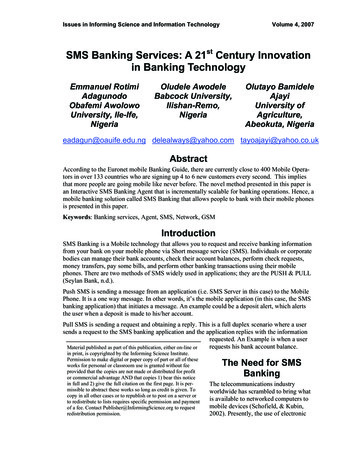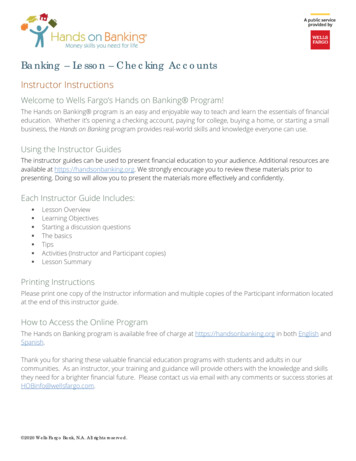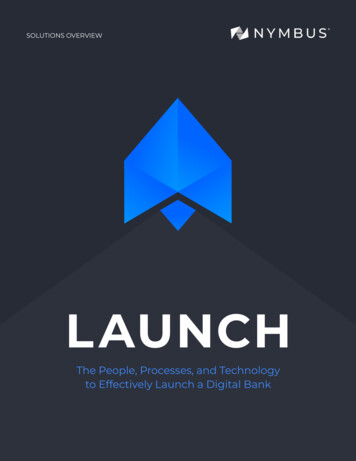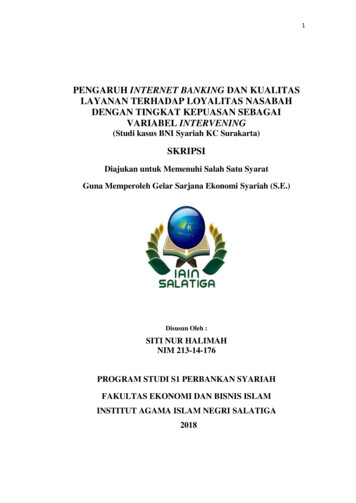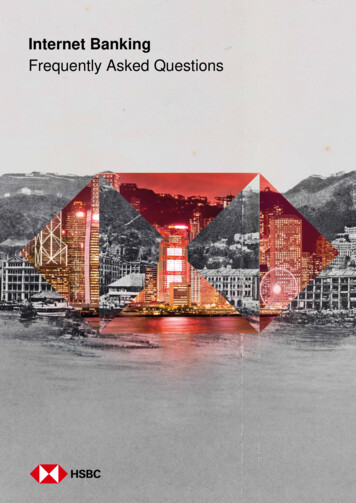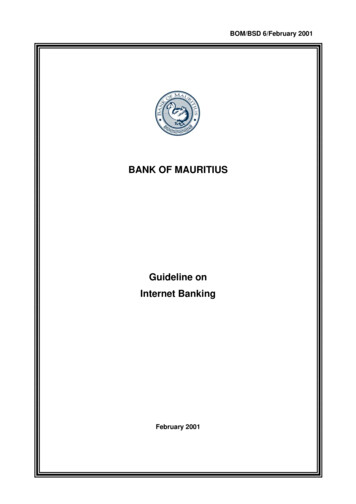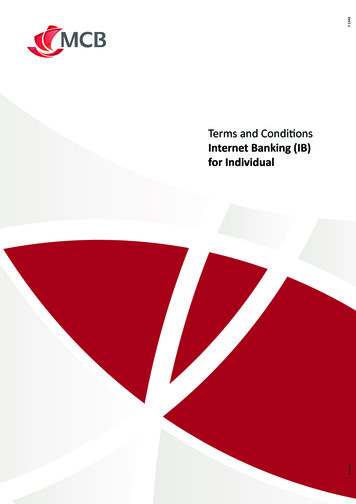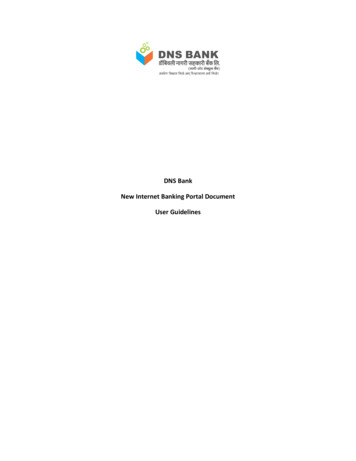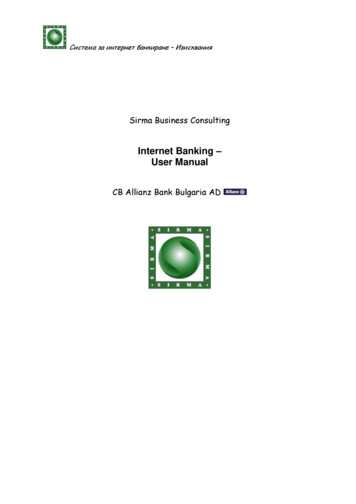
Transcription
Report on Internet BankingChapter-1- IntroductionChapter-2- Internet Banking - a new mediumChapter-3 - International experienceChapter -4 -The Indian ScenarioChapter- 5- Types of risks associated with Internet bankingChapter- 6- Technology and Security Standards For Internet BankingChapter -7 - Legal Issues involved in Internet BankingChapter- 8- Regulatory and supervisory concernsChapter-9 - RecommendationsAnnexure-1Annexure -2Annexure-3Annexure-4Annexure-5Chapter–1– Introduction1.1Background1.1.1 Banks have traditionally been in the forefront of harnessing technology to improve theirproducts, services and efficiency. They have, over a long time, been using electronicand telecommunication networks for delivering a wide range of value added productsand services. The delivery channels include direct dial – up connections, privatenetworks, public networks etc and the devices include telephone, Personal Computersincluding the Automated Teller Machines, etc. With the popularity of PCs, easy accessto Internet and World Wide Web (WWW), Internet is increasingly used by banks as achannel for receiving instructions and delivering their products and services to theircustomers. This form of banking is generally referred to as Internet Banking, althoughthe range of products and services offered by different banks vary widely both in theircontent and sophistication.1.1.2 Broadly, the levels of banking services offered through INTERNET can be categorizedin to three types: (i) The Basic Level Service is the banks’ websites which disseminate
information on different products and services offered to customers and members ofpublic in general. It may receive and reply to customers’ queries through e-mail, (ii) Inthe next level are Simple Transactional Websites which allow customers to submit theirinstructions, applications for different services, queries on their account balances, etc,but do not permit any fund-based transactions on their accounts, (iii) The third level ofInternet banking services are offered by Fully Transactional Websites which allow thecustomers to operate on their accounts for transfer of funds, payment of different bills,subscribing to other products of the bank andto transact purchase and sale ofsecurities, etc. The above forms of Internet banking services are offered by traditionalbanks, as an additional method of serving the customer or by new banks, who deliverbanking services primarily through Internet or other electronic delivery channels as thevalue added services. Some of these banks are known as ‘virtual’ banks or ‘Internetonly’ banks and may not have any physical presence in a country despite offeringdifferent banking services.1.1.3 From the perspective of banking products and services being offered through Internet,Internet banking is nothing more than traditional banking services delivered through anelectronic communication backbone, viz, Internet. But, in the process it has thrownopen issues which have ramifications beyond what a new delivery channel wouldnormally envisage and, hence, has compelled regulators world over to take note of thisemerging channel. Some of the distinctive features of i-banking are:1. It removes the traditional geographical barriers as it could reach out to customersof different countries / legal jurisdiction. This has raised the question of jurisdictionof law / supervisory system to which such transactions should be subjected,2. It has added a new dimension to different kinds of risks traditionally associated withbanking, heightening some of them and throwing new risk control challenges,3. Security of banking transactions, validity of electronic contract, customers’ privacy,etc., which have all along been concerns of both bankers and supervisors haveassumed different dimensions given that Internet is a public domain, not subject tocontrol by any single authority or group of users,4. It poses a strategic risk of loss of business to those banks who do not respond intime, to this new technology, being the efficient and cost effective delivery1
mechanism of banking services,5. A new form of competition has emerged both from the existing players and newplayers of the market who are not strictly banks.1.1.4 The Regulatory and Supervisory concerns in i-banking arise mainly out of thedistinctive features outlined above. These concerns can be broadly addressed underthree broad categories, viz, (i) Legal and regulatory issues, (ii) Security and technologyissues and (iii) Supervisory and operational issues. Legal issues cover those relating tothe jurisdiction of law, validity of electronic contract including the question ofrepudiation, gaps in the legal / regulatory environment for electronic commerce. On thequestion of jurisdiction the issue is whether to apply the law of the area where access toInternet has been made or where the transaction has finally taken place. Allied to this isthe question where the income has been generated and who should tax such income.There are still no definite answers to these issues.1.1.5 Security of i-banking transactions is one of the most important areas of concerns to theregulators. Security issues include questions of adopting internationally accepted stateof-the art minimum technology standards for access control, encryption / decryption (minimum key length etc), firewalls, verification of digital signature, Public KeyInfrastructure (PKI) etc. The regulator is equally concerned about the security policyfor the banking industry, security awareness and education.1.1.6 The supervisory and operational issues include risk control measures, advance warningsystem, Information technology audit and re-engineering of operational procedures.The regulator would also be concerned with whether the nature of products andservices offered are within the regulatory framework and whether the transactions donot camouflage money-laundering operations.1.1.7 The Central Bank may have its concern about the impact of Internet banking on itsmonetary and credit policies. As long as Internet is used only as a medium for delivery ofbanking services and facilitator of normal payment transactions, perhaps, it may notimpact monetary policy. However, when it assumes a stage where private sectorinitiative produces electronic substitution of money like e-cheque, account based cardsand digital coins, its likely impact on monetary system can not be overlooked. Evencountries where i-banking has been quite developed, its impact on monetary policy has2
not been significant. In India, such concern, for the present is not addressed as theInternet banking is still in its formative stage.1.1.8 The world over, central bankers and regulators have been addressing themselves tomeet the new challenges thrown open by this form of banking. Several studies havepointed to the fact that the cost of delivery of banking service through Internet isseveral times less than the traditional delivery methods. This alone is enough reason forbanks to flock to Internet and to deliver more and more of their services throughInternet and as soon as possible. Not adopting this new technology in time has the riskof banks getting edged out of competition. In such a scenario, the thrust of regulatorythinking has been to ensure that while the banks remain efficient and cost effective, theymust be aware of the risks involved and have proper built-in safeguards, machinery andsystems to manage the emerging risks. It is not enough for banks to have systems inplace, but the systems must be constantly upgraded to changing and well-testedtechnologies, which is a much bigger challenge. The other aspect is to provideconducive regulatory environment for orderly growth of such form of banking. CentralBanks of many countries have put in place broad regulatory framework for i-banking.1.1.9 In India, too i-banking has taken roots. A number of banks have set up bankingportals allowing their customers to access facilities like obtaining information, queryingon their accounts, etc. Soon, still higher level of online services will be made available.Other banks will sooner than later, take to Internet banking. The Indian scenario isdiscussed in detail in Chapter-4 of this report.1.2 Constitution of the Working Group1.2.1 In the above background Reserve Bank of India constituted a Working Group toexamine different issues relating to i-banking and recommend technology, security,legal standards and operational standards keeping in view the international bestpractices. The Group is headed by the Chief General Manager–in–Charge of theDepartment of Information Technology and comprised experts from the fields ofbanking regulation and supervision, commercial banking, law and technology. TheBank also constituted an Operational Group under its Executive Director comprisingofficers from different disciplines in the bank, who would guide implementation of therecommendations. The composition of both the Groups isat Annexure-2 and3
Annexure-3.1.2.2 Terms of referenceThe Working Group, as its terms of reference, was to examine different aspects ofInternet banking from regulatory and supervisory perspective and recommendappropriate standards for adoption in India, particularly with reference to thefollowing:1. Risks to the organization and banking system, associated with Internet banking andmethods of adopting International best practices for managing such risks.2. Identifying gaps in supervisory and legal framework with reference to the existingbanking and financial regulations, IT regulations, tax laws, depositor protection,consumer protection, criminal laws, money laundering and other cross border issuesand suggesting improvements in them.3. Identifying international best practices on operational and internal control issues, andsuggesting suitable ways for adopting the same in India.4. Recommending minimum technology and security standards, in conformity withinternational standards and addressing issues like system vulnerability, digitalsignature ,information system audit etc.5. Clearing and settlement arrangement for electronic banking and electronic moneytransfer; linkages between i-banking and e-commerce6. Any other matter, which the Working Group may think as of relevance to Internetbanking in India.1.3. Approach of the Group:1.3.1 The first meeting of the Working Group was held on July 19, 2000. It was decidedthat members of both Working Group and Operational Group would participate in allmeetings and deliberations. The Group, in its first meeting identified the broadparameters within which it would focus its deliberations.1.3.2 The Group agreed that Internet banking is a part of the electronic banking (ebanking), the main difference being that in i-banking the delivery channel wasInternet, a public domain. Although the concerns of e-banking and i-banking havemany things in common, the fact that Internet is a public domain called for additionalsecurity measures. It was agreed that the Group would primarily focus its attention4
on I - banking and to the extent there were commonality between i-banking and ebanking, its recommendation would also apply to e-banking.1.3.3 The Group further held that i-banking did not mean any basic change in the nature ofbanking and the associated risks and returns. All the same, being a public domain anda highly cost effective delivery channel, it does impact both the dimension andmagnitude of traditional banking risks. In fact, it adds new kinds of risk to banking.Some of the concerns of the Regulatory Authority in i-banking relate to technologystandards including the level of security and uncertainties of legal jurisdiction etc. Itscost effective character provides opportunities for efficient delivery of bankingservices and higher profitability and a threat to those who fail to harness it.1.3.4 The Group decided to focus on above three major areas, where supervisory attentionwas needed. Accordingly, three sub-groups were formed for looking into threespecific areas: (i) technology and security aspects, (ii) legal aspects and (iii)regulatory and supervisory issues. The sub-groups could seek help of external expertsin the relevant fields, if needed.1.4Layout of the Report:1.4.1. The views of the Group were crystallized after several rounds of deliberations ofmembers of both the Working Group and the Operational Group. The reportsprepared by the three sub-groups were discussed and assimilated in to this report.The report is presented in nine chapters. Chapter–1, the introductory chapter, givesthe background leading to the formation of the Group, its composition, terms ofreference and the approach adopted by the Group in finalizing its recommendations.1.4.2. The basic structure of Internet and its characteristics are described in Chapter–2 inorder to explain the nature of concerns addressed in the chapters to follow. Alsoexplained in the chapter is the growth of Internet banking and different products anddifferent e-commerce concepts.1.4.3. Chapter–3 describes International experience in i-banking, particularly with referenceto USA, United Kingdom and other Scandinavian countries, who are pioneers in thisform of banking. Chapter- 4 looks at the Indian scenario as it prevails now.1.4.4. Chapter–5 discusses different types of risks associated with banking in general and ibanking in particular. Emphasis is given on normal risks associated with banking5
which gets accentuated when the services are delivered through Internet. Risksrelating to money laundering and other cross border transactions are discussed.1.4.5. Technology and security standards are core concerns for Regulatory Authorities inrelation to Internet banking. A separate sub-group looked in to these issues, whichare discussed in detail in Chapter–6. Emphasis is given on technology and securitystandards and policy issues rather than on products and technical tools.1.4.6 Another important regulatory concern is the legal environment in which i-bankingtransactions are carried out. It is of importance to identify gaps in the existingframework and to suggest changes required. The legal sub-group had made a detailedanalysis of legal questions involved, which are discussed in Chapter – 7.1.4.7 Chapter–8 deals with various control measures required to be adopted by banks tomanage risks discussed in earlier chapters. Operational aspects like internal control,early detection system, IT audit, technical manpower, etc are also discussed. Theimpact of i-banking on clearing and settlement arrangements has also been addressed.The sub-group on Regulatory and Supervisory issues had addressed the abovequestions.1.4.8 Chapter–9 contains recommendations of the Working Group. Shri S. H. Bhojani haddisagreement with some of the observations / recommendations by the Group and anote of dissent is appended as Annexure-1.1.5. Acknowledgement1.5.1 The group wishes to acknowledge and put on record its appreciation of supportreceived from various quarters in completing the Report.1.5.2 The Central Banks and Regulatory Authorities of different countries and the Bank forInternational Settlement were approached for papers compiled by them on the subjectand for details of regulations already in place. All relevant materials were receivedfrom them promptly. The Group gratefully acknowledges their support andcooperation.1.5.3 Shri Girish Vaidya of Infosys technologies Ltd. had made an erudite presentation onInternet Banking to the Group, which was very useful in finalizing this report. TheGroup gratefully acknowledges his efforts.1.5.4 Three sub-groups were formed to focus deliberations on three important aspects of6
Internet banking. These sub-groups utilized the expertise of professionals / bankers infinalizing their views. The convenors and members of sub-groups worked mostdiligently to produce reports of very high quality. The Group gratefully thanks themfor their efforts. The Group gratefully acknowledges the contributions made byS/Shri G. Subba Rao, Head, Internal Audit , ABN Amro Bank, Shri P. C Narayan,Executive Vice President, Global Trust Bank and Shri Sasidharan Menon , Head,Internal Audit , Deutsche Bank as members of sub-group on Regulatory andSupervisory Issues.1.5.5 The Department of Banking Operations and Development provided secretarial serviceto the Working Group. The Group wishes to put on record its appreciation of effortsput in by the secretarial team consisting of DGMs (Shri SR. Das, Shri Arnab Roy),AGM (Shri Indrajit Roy) and Managers (Shri Chetan N Balwir, Dr. T KKarthykeyan, Shri JP Bansal) in organizing the meetings, arranging the backgroundpapers and drafting of the Report.1.5.6 The Group wishes to place on record its appreciation of contributions made by allmembers of the Operational Group who participated in the deliberations and offeredtheir valuable suggestions and guidance.1.5.7 The Member-secretary of the Working Group, Shri M. P. Kothari, worked withutmost zeal in ensuring smooth conduct of the entire process right from the inceptionof the Working Group till the finalization of the Report. The Group gratefullyacknowledges his efforts, but for which the Report would not have been completed.7
Chapter–2– Internet Banking - a new medium2.1Internet – its basic structure and topology2.1.1 Internet is a vast network of individual computers and computer networks connected toand communicate with each other using the same communication protocol – TCP/IP(Transmission Control Protocol / Internet Protocol). When two or more computers areconnected a network is created; connecting two or more networks create ‘internetwork’ or Internet. The Internet, as commonly understood, is the largest example ofsuch a system. Internet is often and aptly described as ‘Information Superhighway’, ameans to reach innumerable potential destinations. The destination can be any one ofthe connected networks and host computers.2.1.2 Internet has evolved to its present state out of a US Department of Defence projectARPANet (Advanced Research Project Administration Network), developed in the late1960s and early 1970s as an experiment in wide area networking. A major perceivedadvantage of ARPANet was that the network would continue to operate even if asegment of it is lost or destroyed since its operation did not depend on operation of anysingle computer. Though originally designed as a defence network, over the years itwas used predominantly in areas of scientific research and communication. By the1980s, it moved out of Pentagon’s control and more independent networks from USand outside got connected to it. In 1986, the US National Science Foundation (NSF)established a national network based on ARPA protocol using commercial telephonelines for connectivity. The NSFNet was accessible by a much larger scientificcommunity, commercial networks and general users and the number of host computersgrew rapidly. Eventually, NSFNet became the framework of today’s Internet.ARPANet was officially decommissioned in 1990.2.1.3 It has become possible for innumerable computers operating on different platforms tocommunicate with each other over Internet because they adopt the samecommunication protocol, viz, TCP/IP. The latter, which stands for ‘TransmissionControl Protocol / Internet Protocol’, is a set of rules which define how computerscommunicate with each other. In order to access Internet one must have an account in8
a host computer, set up by any one of the ISPs (Internet Service Providers). Theaccounts can be SLIP (Serial Line Internet Protocol) or PPP (Point to Point Protocol)account. These accounts allow creating temporary TCP/IP sessions with the host,thereby allowing the computer to join the Internet and directly establish communicationwith any other computer in the Internet. Through this type of connection, the clientcomputer does not merely act as a remote terminal of the host, but can run whateverprograms are available on the web. It can also run several pro
1.3.2 The Group agreed that Internet banking is a part of the electronic banking e- (banking), the main difference being that ini-banking the delivery channel was Internet, a public domain. Although the concerns ofe-banking and i-banking have many things in common, the fact that Internet is

